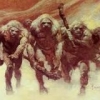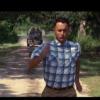Since my last post a month ago, our group has made a day trip every weekend, trying to get to some remote valleys, but found our route blocked by snow still lingering in the high passes. This weekend is a holiday in Canada (Victoria Day on Mon.), and Thomas and I were invited to join 3 of the 4 witnesses from the Jan. 28th sighting near Harrison to examine the hillside where it occurred in further detail, including a night visit with FLIR. Of course we jumped at the chance to use some high end gear, and hear their sighting story again while on the location. We met them for lunch at the Sasquatch Inn on Hwy 7, then convoyed to the site near Harrison. We spent a couple of hours hiking the hillside, looking for any remaining evidence in the very mossy, leaf littered terrain. Winona, the native lady with amazing tracking skills, found a number of large impressions in the forest duff, of appropriate size, spacing, and general shape, but the ground cover couldn't allow any fine detail, such as toe marks, so inconclusive at best. We then proceeded to a favorite mountainside lookout of Thomas and I, well off the main forestry road, which was quite busy with weekend campers, and found peace and quiet for the remainder of the afternoon and evening. With camp chairs circled, our WA. guest, Dave, gave us some lessons in operating his FLIR equipment, and we all compared our field experiences while enjoying Winona's fresh made sandwiches and some cold drinks. Shortly after that evening snack, Thomas had to leave to get to his night shift job, so he missed out on the actual after dark FLIR use.
As the sun set, the temperature dropped quickly, so jackets were donned, and the FLIRs fired up again to scan the extensive older clear cuts nearby, with no luck in spotting any large living creatures. After an hour of scanning the area, we convoyed back to the original sighting spot, and spent another hour scanning that hillside, while listening to what sounded like a barred owl conference going on in the treed slope to our rear. I left their company at about midnight to get home to my bed for a good night's sleep in preperation for another investigation with Thomas of a report of trees very recently pulled down, not cut down, across a hiking trail near Stave Lake, in the District of Mission.
I met Thomas at his home in Mission at 11AM today, allowing him a few hours of beauty sleep after his night job, only to hear that the sighting reporter had postponed meeting us till 2PM, so we waited till 1, then headed out to meet him at the trailhead that he had described. He arrived on time, with his 2 huge dogs, a Rottwieler/Lab cross and an even bigger Great Pyrenes, both very friendly, and very eager to hit the trail. We set of up the trail and soon came to the first of many small groups of from 3 to 5 trees down across the trail , from both sides. These were 6 to 8 inch diameter young fir and hemlock, with the root balls folded up out of the ground, but not completely uprooted. After seeing a half dozen similar sites along about a mile of trail, Thomas and I both came to the conclusion that these were the result of micro-burst wind events that would have occurred during some thunderstorms that passed through the area about 3 weeks ago. There was nothing at all to indicate that they would have been caused by any deliberate action, by bipeds of either the Sasquatch or human variety.



